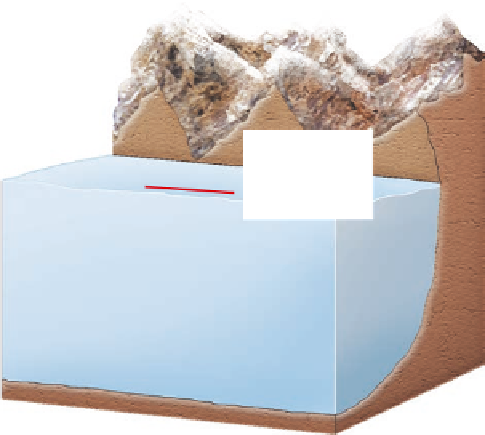Geoscience Reference
In-Depth Information
The Glacial Mass Budget
Glacier development depends on the complex interaction of
snow accumulation in a source area and melting in the zone of
ablation. The advance or retreat of a glacier is governed by the
balance between the input of snow or output due to melting.
In order to better visualize this process, go to the
Geo Media
Library
and select
The Glacial Mass Budget
. This animation
allows you to adjust temperature and the input of snow to influ-
ence the advance or retreat of a glacier. It also provides links to
studies of glacier flow. After you complete the exercise, answer
the questions at the end to test your understanding.
than snow accumulation. Somewhere between the ablation
and accumulation zones is the
equilibrium line
, which marks
the place where system inputs and outputs are in balance.
The overall budget of the glacial system is continually in
flux, with variable amounts of input and output over the course of
time. During periods when the accumulation of snow in the source
area exceeds melting at the zone of ablation, the equilibrium line
moves down the valley and the glacier grows and advances. Con-
versely, when melting in the zone of ablation exceeds the accu-
mulation of snow in the source area, the equilibrium line moves
up the valley and the glacier shrinks and retreats.
Glacier
margin
Glacier
Profile of
horizontal
velocities
(slowest near
glacier margin)
Highest
velocity
at glacier
core
Profile of
vertical
velocities
(slowest near
glacier bed)
Glacial Movement
So how does a glacier move? Contrary to what you may think,
a glacier is not just a block of ice that happens to slide down a
hill. After all, the largest glaciers on Earth moved across fairly
level terrain. This type of movement is possible only because
these massive bodies of ice are able to flow under their own
weight. Most of this movement occurs as a result of
internal
deformation
within the ice. This internal movement is related
to the fact that the interior of a glacier behaves like a plastic
that can be shaped and manipulated to some degree.
Given the relatively high amount of friction that exists be-
tween the ice and the rock on which it flows, the ice moves
most quickly in the core of the glacier (Figure 17.5). In this
way ice-flow dynamics are quite similar to those observed in
a stream system. However, in contrast to streams, which flow
quickly, average glacial flow is on the order of 10 cm to 30 cm
(about 4 in. to 12 in.) per day. This internal deformation con-
tinues even if the glacier is melting, shrinking, and retreating.
In other words, the interior of the glacier continues to move
forward
even though
the front of the glacier may actually be re-
treating up the mountain valley as a result of fluctuations within
the overall mass budget (Figure 17.6).
Not all the ice is plastic, however. The upper part of the ice
is quite brittle and breaks easily. When this part of the glacier
fractures, prominent
crevasses
can develop that extend from the
surface of the ice to some depth within it. Crevasses usually form
Glacier bed
Movement of
glacier due to
sliding along bed
Figure 17.5 Internal flow in a glacier.
Glacial ice is a
plastic substance that flows under its own weight. Because
of friction, the ice flows more slowly on its edge and base
where it is in contact with bedrock. Velocity gradually in-
creases toward the core of the glacier because it can move
more freely.
when the ice flows over a small ridge in the bedrock below (Fig-
ure 17.7). This ridge causes compression to build in the ice on the
up-valley side of the ridge. On the downstream side of the ridge,
the ice stretches, causing tension to build and crevasses to form.
Crevasses are most closely associated with the equilibrium line
because that is the place where they become visible as you move
down the glacier (see Figure 17.4). These giant cracks in the ice
are visible in the zone of ablation because they are not covered by
fresh snow. In the zone of accumulation, however, they are not as
visible because fresh snow tends to hide them.
Equilibrium line
The place on a glacier where snow accumu-
lation and melting are in balance.
A deep crack in a glacier.
Crevasse














































